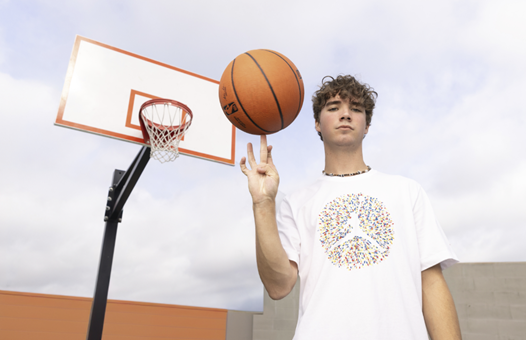His first time at Cannes, Evan Spiegel is already star of the show
Spiegel admits to being a little nervous ahead of his first trip to the Cannes Lions International Festival of Creativity. That’s understandable. At 25—an age when many college grads are still backpacking around Europe—the founder and CEO of Snapchat has been given top billing at one of advertising’s biggest events.
In a way, it represents an introduction to the ad world for the young company, a social media darling founded in 2011. Snapchat has built an addictive and innovative product that reaches an elusive but alluring audience, and now it must build a billion-dollar business out of it.
“Anytime you do something for the first time, it’s nerve-racking,” Spiegel confesses in a conversation with Adweek just ahead of his trip to this annual gathering for the advertising elite on the French Riviera. “And I’ve never built an ad business before.”

Founder of the hottest app for teens and millennials
When he takes the main stage at Cannes, 6,000 of the agency world’s top creatives and deal makers will be eager to hear his pitch. “If people show up,” he says, half joking. Spiegel is quite aware, after all, that he is in command of a fan base of 100 million consumers who use the app daily and obsessively—a group advertisers would love to get in front of. The vast majority of Snapchat’s users are young and latched to their phones like kids in the ’50s were fixated on TV. According to stats the company shared, 63 percent of the app’s monthly users are between the age of 13 and 24. Snapchat has not divulged total monthly users but estimates put it at 200 million-plus.
By most measures, Snapchat has reached phenomenon status. It has changed the way teenagers use their phones, and how media companies like the Daily Mail and Vice Media publish on mobile devices, and how the NBA promotes its championship games—and now, how advertisers approach digital creative campaigns.
While Cannes has become a destination for the digirati—with reps from Google, Facebook, Microsoft, Yahoo, Twitter, Pinterest, LinkedIn, Instagram and more jetting in this year—there is little question that Spiegel is one of the top tech stars heading there. In recent years, young tech entrepreneurs like him have been known to make the Croisette a first stop before Madison Avenue. In 2013, David Karp of Tumblr—which had just sold to Yahoo—stepped on the main stage at the Palais.
This year, Pinterest and Instagram look like daunting rivals for marketers’ affections, as both just launched supercharged ad platforms with new APIs, targeting technology and formats. Meanwhile, companies like Facebook, Yahoo and LinkedIn each have deep advertising teams headed to France with dozens of beachside meetings and parties planned.
Think vertically
Spiegel will be coming at the ad industry with a whole new perspective—literally. The CEO will be talking at Cannes about one of the key changes Snapchat has inspired in digital video: to think vertically. He and many other social, mobile and video players are beginning to detect that “people just don’t rotate their phones,” he says. That’s why advertisers that have been first to test-drive marketing on the app see a reported nine times more engagement when their ads are vertically oriented.
When video is shot in landscape (horizontal) mode, it only takes up a small space in the center of a vertical screen until the viewer turns the device on its side. And really, who can be bothered? “A lot of folks in the transition to mobile—which is still ongoing—were taking video that was formatted for livestream desktop and TV, and they were jamming that creative into a mobile feed,” Spiegel says. “That makes sense in the evolution from desktop to mobile, but since we started on mobile, it’s a blank canvas … Our baseline was, [we want] full screen. And in order to get full screen, you’ve got to do vertical video.”
Snapchat delivers this new style of verticality in all its content—messaging, Live Stories and Discover channels. The messaging is for users to send photos, videos and drawings back and forth. Live Stories are crowdshared videos from around the world and at important events. The Discover channels are published daily by select media partners like Cosmopolitan, Daily Mail, Vice, ESPN and Comedy Central.
After a few ad experiments and price adjustments, Snapchat now sells sponsored video space in Discover and Live Stories, and recently ran a branded story with Bud Light. The video ads are priced competitively compared to rivals like Instagram, at $20 for every 1,000 views.
It’s an adjustment that had to happen. One digital buyer who has a close relationship with Snapchat’s publishing partners and advertisers says the company is starting to get pricing right after first asking for too much. Snapchat was offering $750,000-a-day packages but has since become more affordable. “They embraced prices coming down,” says the exec.
Advertising is definitely starting to roll in. McDonald’s and Samsung have come aboard, while Macy’s recently sponsored People’s Discover feed. Movie studios are also playing with the app. The big summer releases Mad Max: Fury Road, Pitch Perfect 2 and Jurassic World all were heavily promoted on the app.
Speaking on the condition of anonymity, the buyer says Snapchat is starting to live up to its potential in social media marketing. “It’s actually quite a mature company,” the exec adds. “A lot of companies come out and don’t have their acts together.”
Avoiding the creepy factor
Spiegel has been open to pursuing rich advertising avenues from the start, understanding the need to turn a simple idea into a powerful moneymaker. But Snapchat faces one rather large hurdle that rivals like Facebook and its sister-app Instagram have not: a foundation in anonymity.

More than 60 percent of U.S. smartphone users ages 13-34 use Snapchat. Eighty-six percent of Snapchatters are 34 or younger.
The app represented a fundamental change in the digital mindset. Its disappearing photos and videos, set to self-destruct within 10 seconds, meant users didn’t have to worry about leaving tracks behind them. Those tracks, however, are often the pathway to targeted, relevant advertising that brands demand be paved for them.
Spiegel says he finds targeted advertising creepy. “Some of the stuff that happens on the Internet—like when a product you didn’t end up buying follows you around—that ends up feeling strange and maybe even winds up doing brand damage,” he explains. Spiegel feels there’s an opportunity to grow the business to live up to its $16 billion valuation without resorting to such tactics. “We have a really big business here that also respects the privacy of people who use Snapchat,” he says.
He promises that there will be no invasive consumer data caches for marketers, explaining, “We’re going to stay away from building really extensive profiles on people because that’s just bad and doesn’t feel very good.”
That lack of a clear window into Snapchatters gives pause to data-minded marketers like Eric Beane, managing director of analytics and data insights at digital marketing firm VML, which does social campaigns for marketers including Wendy’s and Gatorade. “Snapchat is tough for brands,” he says. “There’s no real way to track and understand the conversation there.”
That said, it’s also where millennials and even younger audiences are taking their conversations. “It’s still new ground to understand what’s the best way to utilize for marketing and advertising,” Beane says.
It’s new ground for content partners, too. Discover partner and Cosmo editor in chief Joanna Coles will interview Spiegel on stage at Cannes about how mobile millennials behave and consume. “We’re talking to him on the main stage about creativity and millennials, and what he thinks will excite them next,” Coles reveals.
Cosmo gets 1.82 million Snapchat viewers each day and attracts sponsors like Maybelline. That’s a big daily audience for the Hearst publication, whose website attracts as many as 40 million unique visitors every month. Coles says that Cosmo handles most of the ad sales on its Discover channel. Partners split revenue with Snapchat. “The beauty of content on Discover is it’s sort of short and it’s curated to be experienced in a certain way,” the editor says. “It’s perfectly devised for a cellphone.”
Publishers like Cosmo and Daily Mail are branching out in all digital directions, staking out any audience they can find, whether from Facebook’s Instant Articles or Apple’s newly launched News app. These are the platforms with the most stylish layouts and interactive features for publications and marketers.
Snapchat was once again at the edge of media innovation with its launch of Discover in January. “Evan runs the company like a startup. He wanders into my office unannounced and asks for feedback on Discover and the ad products,” says Daily Mail North America CEO Jon Steinberg. “We also go to him and his team with questions about media, community and the novel formats they’re rolling out.”
Major media partners are trying new techniques with Snapchat, incorporating GIF-like images that act as entryways into stories as well as stylish animations, colorful content and even long-form articles. And most of it is fit for the vertical experience.
Steinberg, who will meet with Spiegel on Daily Mail’s yacht in Cannes for an informal talk with advertisers, compares the young CEO’s leadership style to that of WPP Group CEO Martin Sorrell. “He doesn’t believe in bureaucracy and hierarchy” and “he’s interested in ideas and doing big things and standing by your word,” says the exec. “I love the guy, and I don’t say that about everybody.”
Perhaps Discover’s biggest challenge is that it remains a sideshow to Snapchat’s main messaging attraction, placed two long swipes over from the camera screen that appears when one opens the app. “Discover is sort of hidden, and that was an effort to make sure we get the channels really great and the content working,” Spiegel explains. “Now that we see that, ‘Hey, this is engaging,’ we’ll explore bringing that front and center.”
In advance of Cannes, Spiegel shares new marketing material developed for the ad industry. Snapchat’s got a “3V” approach, its nickname for “vertical, video and views,” and with 2 billion views a day, it’s got half the number of views Facebook gets per day with 1.4 billion users.

Snapchat gets more than 2 billion video views a day.
Snapchat’s pitch stresses the impact of full-screen ad units on mobile compared to the in-feed units on apps like Facebook, Instagram and Twitter. Snapchat is getting about 35 million users ages 13-34 each day in the U.S., a number that, it says, approaches the TV audience for the same age group. (For example, ABC’s recent broadcast of the American Music Awards got 3 million viewers 13-34, while a Snapchat Live Story about the event drew 11.5 million.)
It is such numbers that make Gian LaVecchia, head of digital content marketing at MEC Network, a believer. “I’m really bullish on Snapchat,” says LaVecchia. “It’s not sleeping anymore.”
And the ad world seems eager to get a glimpse of what Snapchat might do—and not do—at Cannes. The time is right, given the company’s elusive sales presence, says Chris Tuff, 22squared’s evp and director of business development and partnerships. “They’re like a unicorn, that team everyone wants to get in front of but can’t find because they’re in such high demand and are spread so thin,” as Tuff puts it. “Last year, it was Pinterest. Now, it’s Snapchat’s turn.”
By Garett Sloane









